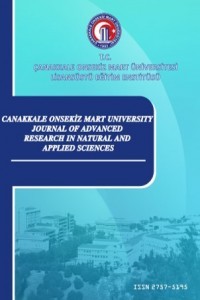Heavy Oil Residue Upgrading With Iron Based Catalysts Under High Hydrogen Pressure
In this study, effective and easily accessible cheap catalysts that assist converting heavy oil residue to lighter products with high yield are investigated. Hydrocracking experiments were carried out in a 10 ml stainless steel bomb-type reactor with up and down stirrer at 200 times of reciprocation per minute. The catalyst mixture provided the minimum coke yield was investigated. FeSO4.H2O, the binary mixtures of FeSO4.H2O with metal oxides (Fe2O3, Al2O3, CaO, SiO2) and the mixtures Fe2O3, Al2O3 and SiO2 with elementary sulphur were used as catalyst. Experiments were conducted at 425 0C for 90 minutes with the initial pressure 100 bar H2. The amount of coke, liquid products and C5- gas products were calculated for each experiment. Gel Permeation Chromatography (GPC), Nuclear Magnetic Resonance (1H NMR) and elemental analysis were used for Iranian heavy oil residue. Differential Scanning Calorimeter (DSC) was used to analyze the catalyst. According to the results, minimum coke yield is achieved by FeSO4.H2O+SiO2 catalyst. Although minimum coke yield achieved with FeSO4.H2O+SiO2, middle distillate containing toluene soluble fraction (TSF) was maximized with Fe2O3+Al2O3+Sulphur catalyst mixture. In addition, the product selectivity in the reactions with the least coke formation showed selectivity in the direction of the formation of gas and light products, not in the direction of liquid product formation.
Keywords:
Heavy Oil Iron catalysts, Residue, Residue Upgrading, Slurry phase hydrocracking reactions,
___
- Bearden R. Jr., Aldridge C.L., (1978), Hydroconversion process, U.S. Patent No: 4,067,799 https://patents.google.com/patent/US4067799A/en?oq=U.S.+Patent+No:+4%2c067%2c799
- Belinko K., Khulbe C. P., Jain A. K., (1990), Hydrocracking of heavy oil in presence of ultrafi-ne iron sulfate, U.S. Patent No: 4,963,247 https://patents.google.com/patent/US4963247A/en?oq=U.S.+Patent+No:+4%2c963%2c247
- Bhattacharyya A., Bricker M. l., Mezza B. J., Bauer L. J., (2011), Process for using iron oxide and alumina catalyst with large particle diameter for slurry hydrocracking, U.S. Patent No: 8,062,505 B2 https://patents.google.com/patent/US8062505B2/en?oq=U.S.+Patent+No:+8%2c062%2c505+B2+
- Bin Liu, Kedi Zhao, Yongming Chai, Yanpeng Li, Di Liu, Yunqi Liu, Chenguang Liu, (2019) Slurry phase hydrocracking of vacuum residue in the presence of presulfided oil-soluble MoS2 ca-talyst, Fuel, Volume 246, Pages 133-140. https://doi.org/10.1016/j.fuel.2019.02.114
- Farzanegan, M.R., (2011), Oil revenue shocks and government spending behaviour in Iran, Energy Economics. 33, 1055-1069. https://doi.org/10.1016/j.eneco.2011.05.005
- Hongwei Ma, Haowei Li, Weijie Zhao, Lixia Li, Sijie Liu, Jinxing Long and Xuehui Li. (2019). Selective depolymerization of lignin catalyzed by nickel supported on zirconium phosphate, Green Chemistry, 21/3, 658- 668. https://doi.org/10.1039/C8GC03617A
- Jain A.K., Pruden B.B., (1991), Hydrocracking of heavy oils in presence of petroleum coke de-rived from heavy oil coking operations, U.S. Patent No: 4,999,328 https://patents.google.com/patent/US4999328A/en?oq=U.S.+Patent+No:+4%2c999%2c328
- JBC Energy Global Refinery Margins Weekly Report (2013),W 3. https://www.jbcenergy.com/publications/refining-views
- Lott R.K., Cyr T., Lee L.K., (1991), Process for reducing coke formation during hydroconver-sion of heavy hydrocarbons, Canadian Patent No: 2,004,882 https://www.osti.gov/etdeweb/biblio/5349661
- M.J.Angeles, C. Leyva, J. Ancheyta, S. Ramírez, (2014) A review of experimental procedures for heavy oil hydrocracking with dispersed catalyst, Catalysis Today, Volumes 220–222, Pages 274-294, https://doi.org/10.1016/j.cattod.2013.08.016
- Pedro Álvarez, Barbara Browning, Tim Jansen, Maxime Lacroix, Christophe Geantet, Isabelle Pitault, Melaz Tayakout-Fayolle (2019), Modeling of atmospheric and vacuum petroleum residue hyd-roconversion in a slurry semi-batch reactor: Study of hydrogen consumption, Fuel Processing Techno-logy, Volume 185 Pages 68-78 https://doi.org/10.1016/j.fuproc.2018.11.016
- Reynolds, B. E., Rogers, J. L., Spieler, S., & Broussard, R. A. (1998), Resid Conversion Options. Chevron Research and Technology, No. 073 https://www.researchgate.net/profile/Rajeev-Kumar-17/publication/276277040_Optimize_hydrogen_management_for_distillate_production/links/55561d9708ae6fd2d8235ea4/Optimize-hydrogen-management-for-distillate-production.pdf
- Suk Hyun Lim, Kang Seok Go, Eun Hee Kwon, Hai Hung Pham, Nam Sun Nho, Kwang Ho Kim, Jae Goo Lee, Sung-youl Park, (2021), Change of physical properties with the slurry-phase hyd-rocracking reaction of vacuum residue, Journal of Industrial and Engineering Chemistry,Volume 98, Pages 425-434, https://doi.org/10.1016/j.jiec.2021.03.022
- Sung-Ho Kim, Ki-Duk Kim, Yong-Kul Lee, (2017), Effects of dispersed MoS2 catalysts and re-action conditions on slurry phase hydrocracking of vacuum residue, Journal of Catalysis,Volume 347,Pages 127-137 http://dx.doi.org/10.1016/j.jcat.2016.11.015
- Tareq A. Al-Attas, Syed A. Ali, Md Hasan Zahir, Qingang Xiong, Saad A. Al-Bogami, Zuhair O. Malaibari, Shaikh A. Razzak, and Mohammad M. Hossain, (2019) Recent Advances in Heavy Oil Upgrading Using Dispersed Catalysts Energy & Fuels 33 (9), 7917-7949 https://doi.org/10.1021/acs.energyfuels.9b01532
- Torchia, D., Arora, A., and Vo, L. (2012), Clean, green, hydrocracking machine. Hydrocarbon engineering, 17(6). https://www.hydrocarbonengineering.com/magazine/hydrocarbon-engineering/june-2012/
- Zhang, S., Liu, D., Deng, W., & Que, G., (2007), A review of slurry-phase hydrocracking heavy oil technology, Energy & Fuels, 21-6, 3057-3062. https://pubs.acs.org/doi/10.1021/ef700253f
- Yayın Aralığı: Yılda 4 Sayı
- Başlangıç: 2015
- Yayıncı: Çanakkale Onsekiz Mart Üniversitesi
